1995 GMC SIERRA wheel
[x] Cancel search: wheelPage 73 of 488
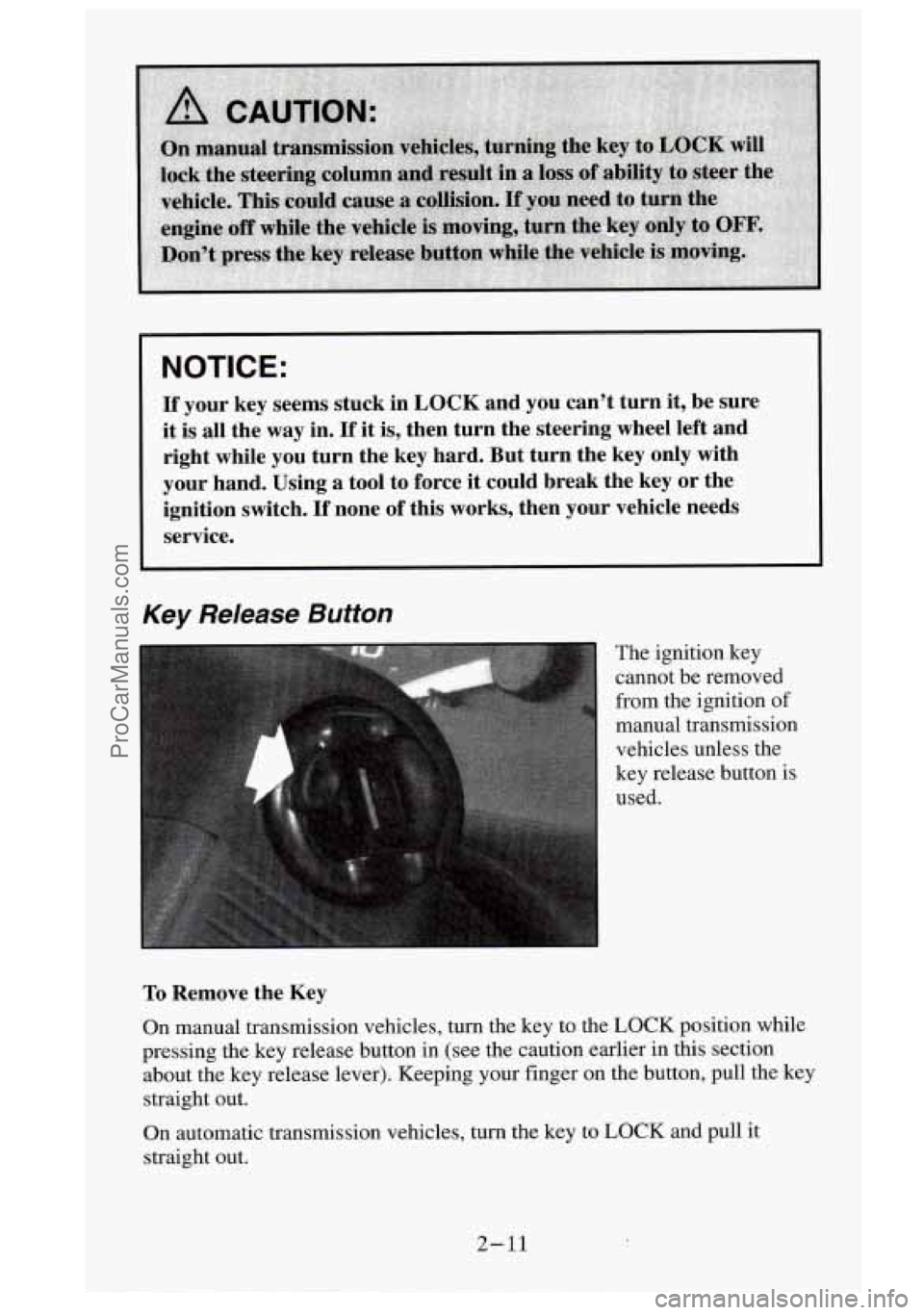
ITICE:
If your key seems stuck in LOCK and you can’t turn it, be sure
it is all the
way in. If it is, then turn the steering wheel left and
right while you turn the key hard. But turn the key only with
your hand. Using
a tool to force it could break the key or the
ignition switch.
If none of this works, then your vehicle needs
service.
Key Release Button
The ignition key cannot be removed
from the ignition
of
manual transmission
vehicles unless the
key release button is
used.
To Remove the Key
On manual transmission vehicles, turn the key to the LOCK position while
pressing the key release button in (see the caution earlier i\
n this section about the key release lever). Keeping your finger on the butt\
on, pull the key straight out.
On automatic transmission vehicles,
turn the key to LOCK and pull it
straight cwt.
2-11
ProCarManuals.com
Page 81 of 488
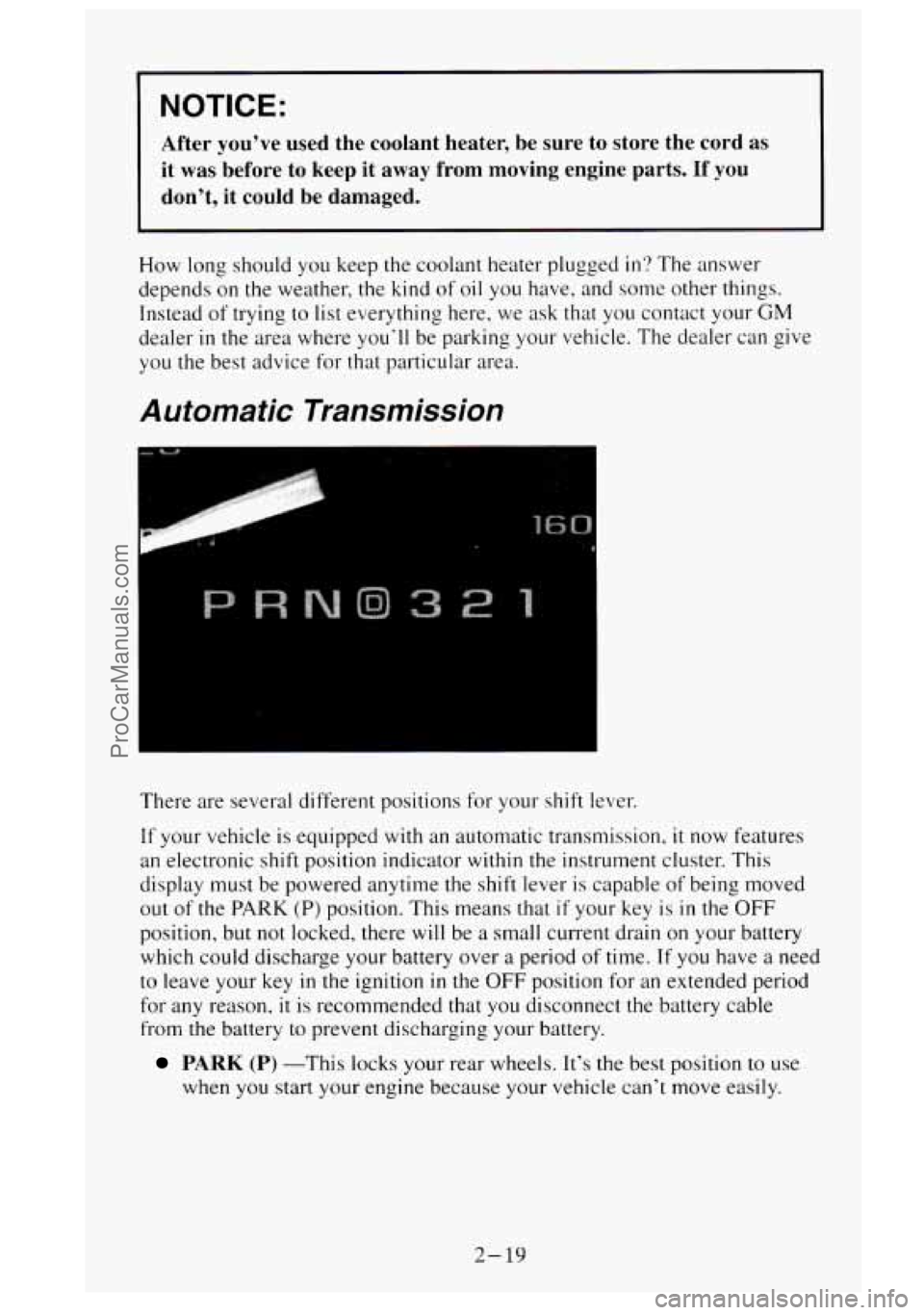
NOTICE:
After you’ve used the coolant heater, be sure to store the cord as
it was before to keep
it away from moving engine parts. If you
don’t,
it could be damaged.
How long should you keep the coolant heater plugged in? The answer
depends on the weather, the kind of oil you have. and some other things.
Inste.ad of trying
to list everything here, we ask that you contact your GM
dealer in the area where you‘ll be parking your vehicle. The dealer can give
you the best advice for that particular area.
Automatic Transmission
There are several different positions for your shift lever.
If your vehicle is equipped with an automatic transmission, it now features
an electronic shift position indicator
within the instrument cluster. This
display must be powered anytime the shift lever is capable
of being moved
out of the
PARK (P) position. This means that if your key is in the OFF
position, but not locked, there will be a small current drain on your battery
which could discharge your battery over
a period of time. If you have a need
to leave your key
in the ignition in the OFF position for an extended period
for any reason,
it is recommended that you disconnect the battery cable
from the battery to prevent discharging your battery.
PARK (P) -This locks your rear wheels. It’s the best position to use
when you start your engine because your vehicle can’t move easily.
2- 19
ProCarManuals.com
Page 82 of 488
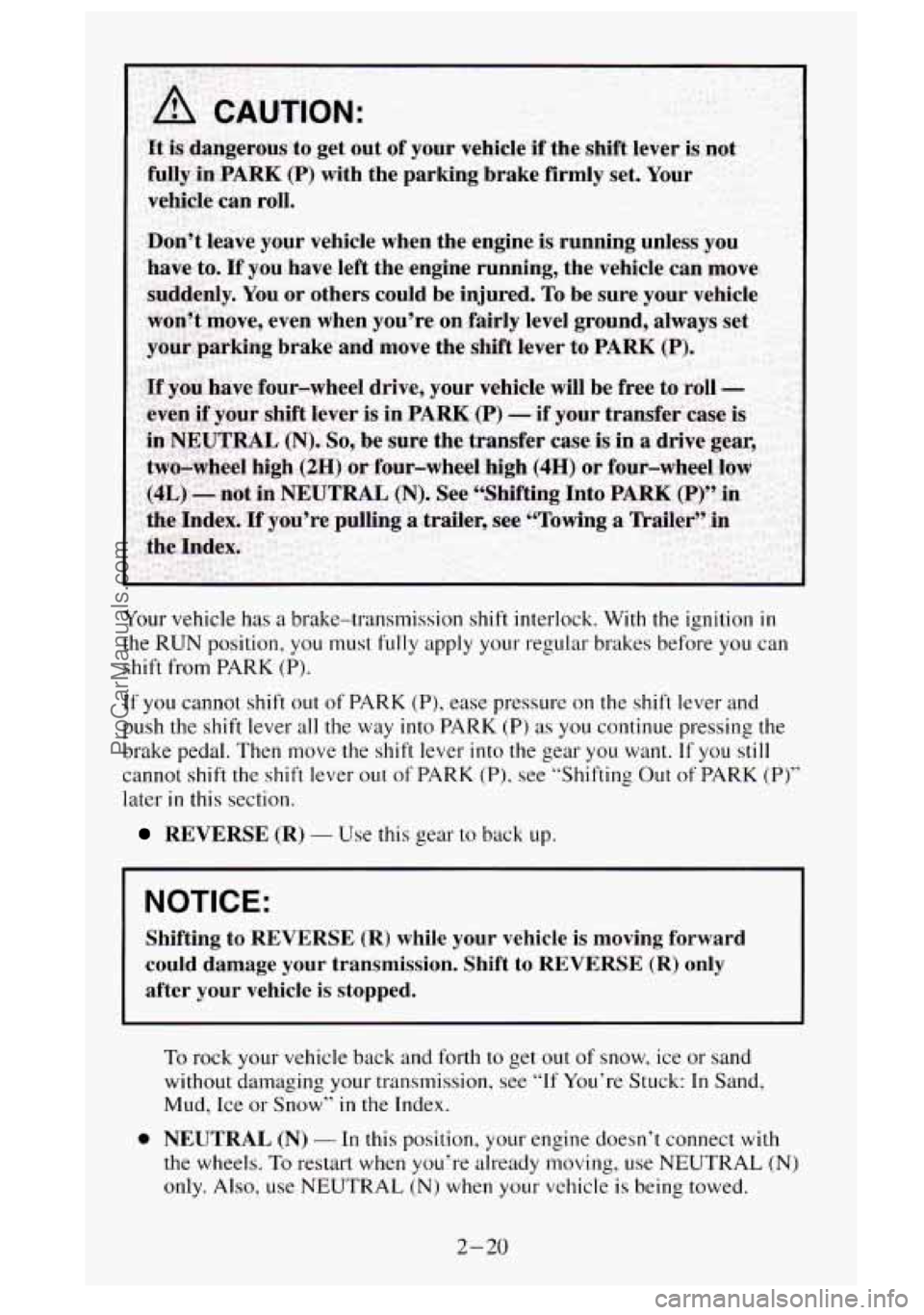
Your vehicle has a brake-transmission shift interlock. With the ignition in
the RUN position, you must fully apply your regular brakes before you can
shift from PARK (P).
If you cannot shift out of PARK (P), ease pressure on the shift lever and
push the
shift lever all the way into PARK (P) as you continue pressing the
brake pedal.
Then move the shift lever into the gear you want. If you still
cannot shift the shift lever out of
PARK (P), see ”Shifting Out of PARK (P)”
later in this section.
REVERSE (R) - Use this gear to back up.
NOTICE:
Shifting to REVERSE (R) while your vehicle is moving forward
could damage your transmission. Shift to REVERSE
(R) only
after your vehicle is stopped.
To rock your vehicle back and forth to get out of snow, ice or sand
without damaging your transmission, see
“If You‘re Stuck: In Sand,
Mud, Ice or Snow”
in the Index.
a NEUTRAL (N) - In this position, your engine doesn’t connect with
the wheels. To restart when you’re already moving, use NEUTRAL (N)
only. Also, use NEUTRAL (N) when your vehicle is being towed.
2-20
ProCarManuals.com
Page 83 of 488
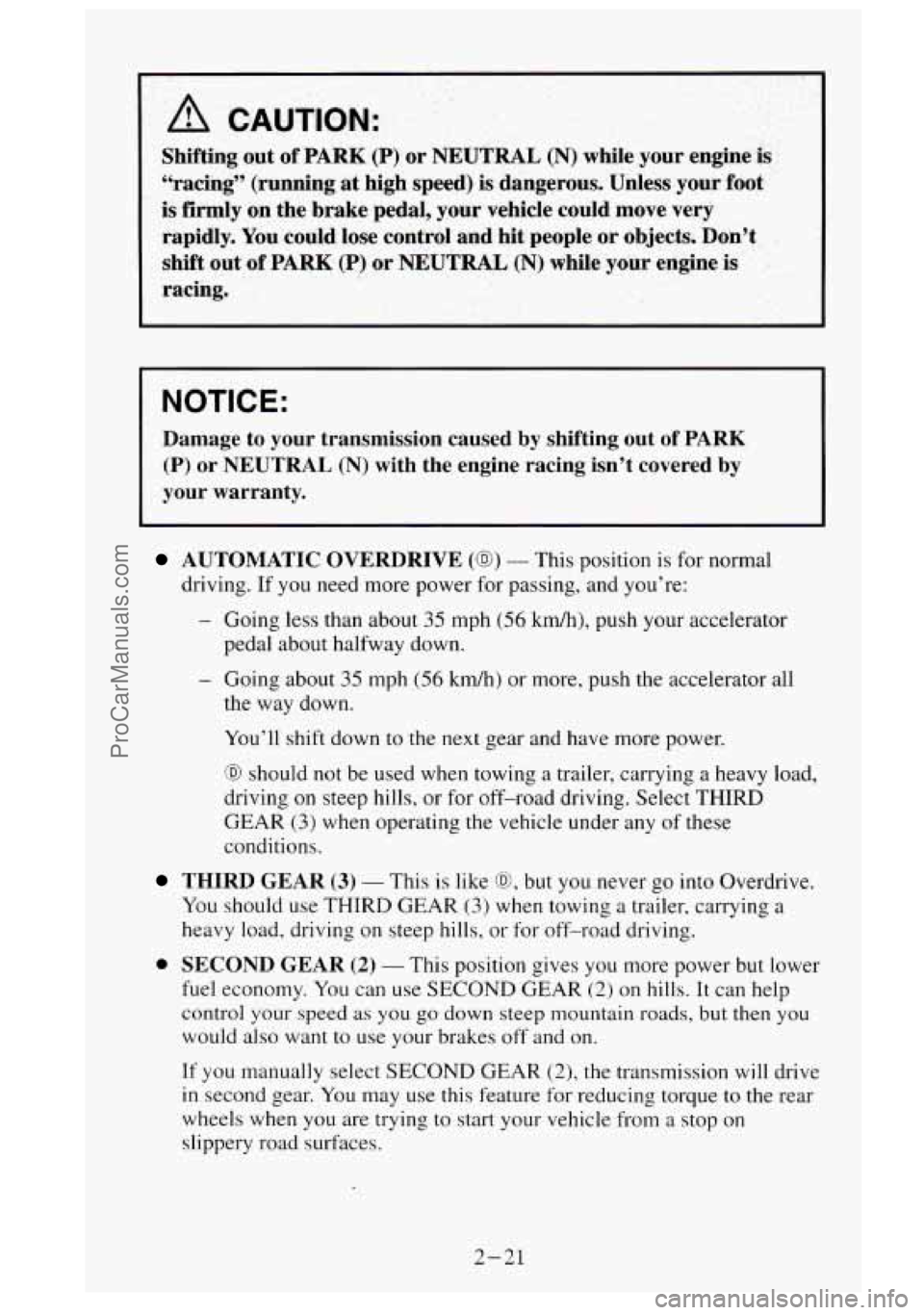
A CAUTION:
Shifting out of PARK (f) or NEUTRAL (N) while your engine is
“racing” (running at high speed) is dangerous. Unless your foot
is firmly on the brake pedal, your vehicle could move very
rapidly.
You could lose control and hit people or objects. Don’t
shift out of
PARK (P) or NEUTRAL (N) while your engine is
racing.
NOTICE:
Damage to your transmission caused by shifting out of PARK
(P) or NEUTRAL (N) with the engine racing isn’t covered by
your warranty.
AUTOMATIC OVERDRIVE (a) - This position is for normal
driving. If you need more power for passing, and you’re:
- Going less than about 35 mph (56 km/h), push your accelerator
pedal about halfway down.
the way down.
You’ll shift down to the next gear and have more power.
- Going about 35 mph (56 kdh) or more, push the accelerator all
0 should not be used when towing a trailer, carrying a heavy load,
driving on steep hills, or for off-road driving. Select THIRD
GEAR
(3) when operating the vehicle under any of these
conditions.
THIRD GEAR (3) - This is like 63, but you never go into Overdrive.
You should use
THIRD GEAR (3) when towing a trailer. carrying a
heavy load, driving on steep hills, or
for off-road driving.
0 SECOND GEAR (2) - This position gives you more power but lower
fuel economy. You can use
SECOND GEAR (2) on hills. It can help
control
your speed as you go down steep mountain roads, but then you
would also want
to use your brakes off and on.
If you manually select SECOND GEAR (2), the transmission will drive
in second gear. You may use this feature for reducing torque to the rear
wheels when you are trying
to start your vehicle from a stop on
slippery road surfaces.
2-21
ProCarManuals.com
Page 84 of 488
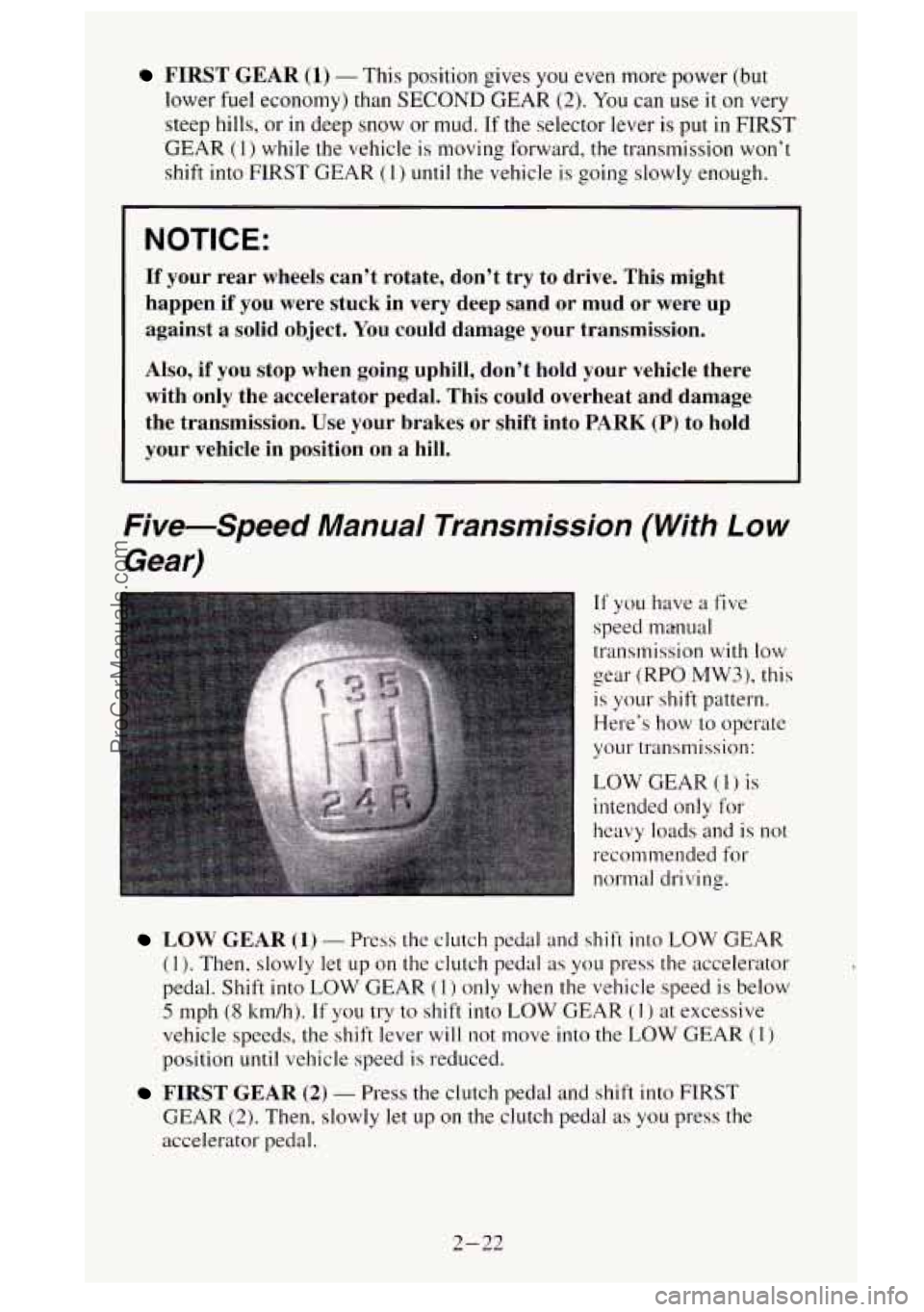
FIRST GEAR (1) - This position gives you even more power (but
lower
fuel economy) than SECOND GEAR (2). You can use it on very
steep hills, or in deep snow or mud. If the selector lever is put in FIRST
GEAR (1) while the vehicle is moving forward, the transmission won’t
shift into FIRST GEAR
(1) until the vehicle is going slowly enough.
NOTICE:
If your rear wheels can’t rotate, don’t try to drive. This might
happen if you were stuck in very deep sand
or mud or were up
against a solid object.
You could damage your transmission.
Also, if you stop when going uphill, don’t hold your vehicle there
with only the accelerator pedal. This could overheat and damage
the transmission.
Use your brakes or shift into PARK (P) to hold
your vehicle in position on a hill.
Five-Spa-ld Manual Transmission (With Low
Gear)
If you have a five
speed manual
transmission with
low
gear (RPO MW3), this
is your shift pattern.
Here’s how to operate
your transmission:
LOW GEAR (1) is
intended only for
heavy loads and is
not
recommended for
normal driving.
LOW GEAR (1) - Press the clutch pedal and shift into LOW GEAR
(1). Then, slowly let up on the clutch pedal as you press the accelerator
pedal. Shift into
LOW GEAR (1) only when the vehicle speed is below
5 mph (8 km/h). If you try to shift into LOW GEAR (I ) at excessive
vehicle speeds, the shift lever
will not move into the LOW GEAR (1)
position until vehicle speed is reduced.
FIRST GEAR (2) - Press the clutch pedal and shift into FIRST
GEAR (2). Then, slowly let up on the clutch pedal as you press the
accelerator pedal.
2-22
ProCarManuals.com
Page 87 of 488
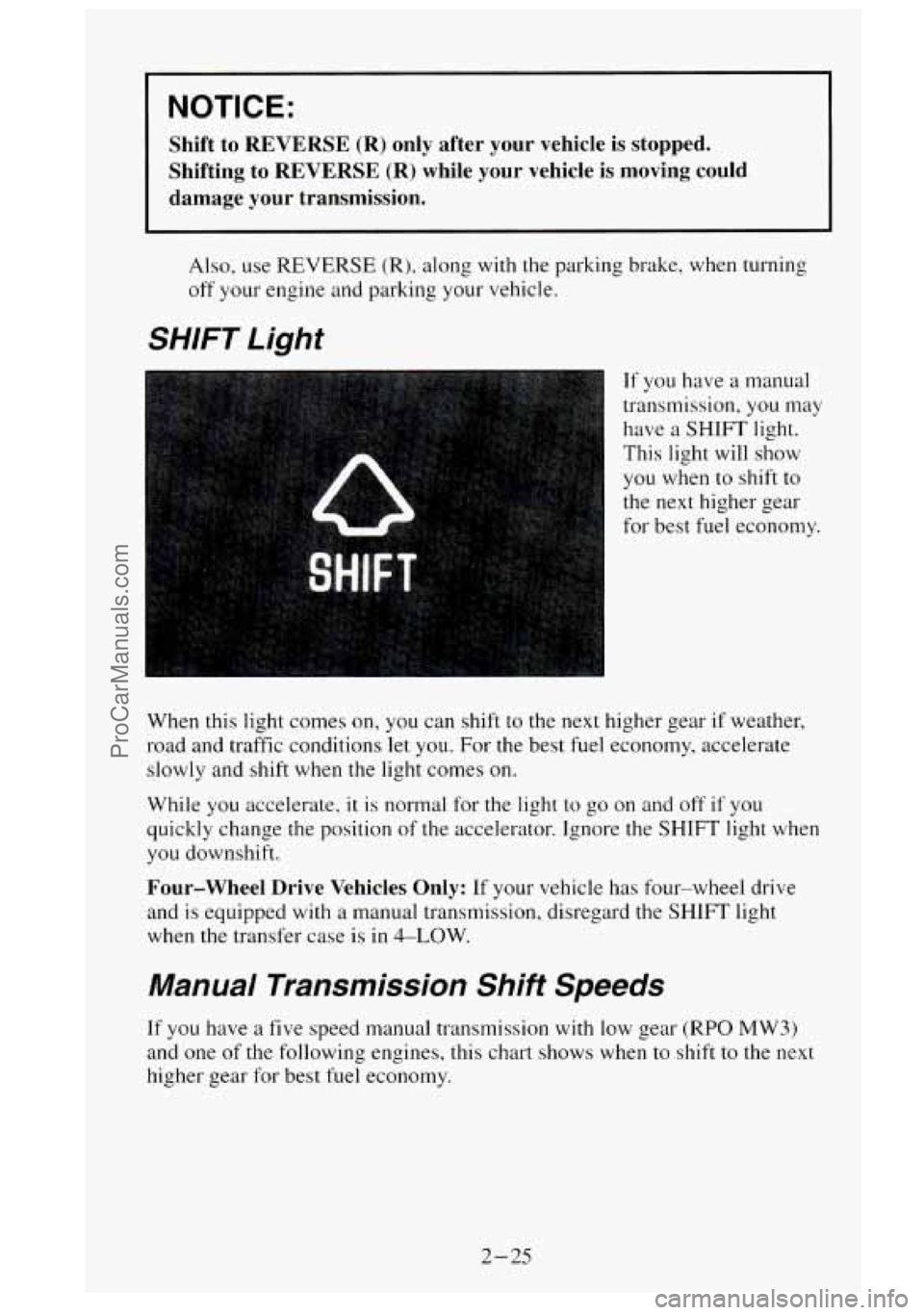
NOTICE:
Shift to REVERSE (R) only after your vehicle is stopped.
Shifting to REVERSE
(R) while your vehicle is moving could
damage
your transmission.
Also, use REVERSE (R), along with the parking brake, when turning
off your engine and parking your vehicle.
SHIFT Light
If you have a manual
transmission, you may
have
a SHIFT light.
This light will show
you when
to shift to
the
next higher gear
for best
fuel economy.
When this light comes on, you can shift to the
next higher gear if weather,
road and traffic conditions let you.
For the best fuel economy, accelerate
slowly and shift when the light comes on.
While you accelerate,
it is normal for the light to go on and off if you
quickly change the position of the accelerator. Ignore the
SHIFT light when
you downshift.
Four-wheel Drive Vehicles Only: If your vehicle has four-wheel drive
and is equipped with a manual transmission, disregard the
SHIFT light
when
the transfer case is in 4-LOW.
Manual Transmission Shift Speeds
If you have a five speed manual transmission with low gear (RPO MW3)
and one of the following engines, this chart shows when to shift to the next
higher gear for best fuel economy.
2-25
ProCarManuals.com
Page 89 of 488
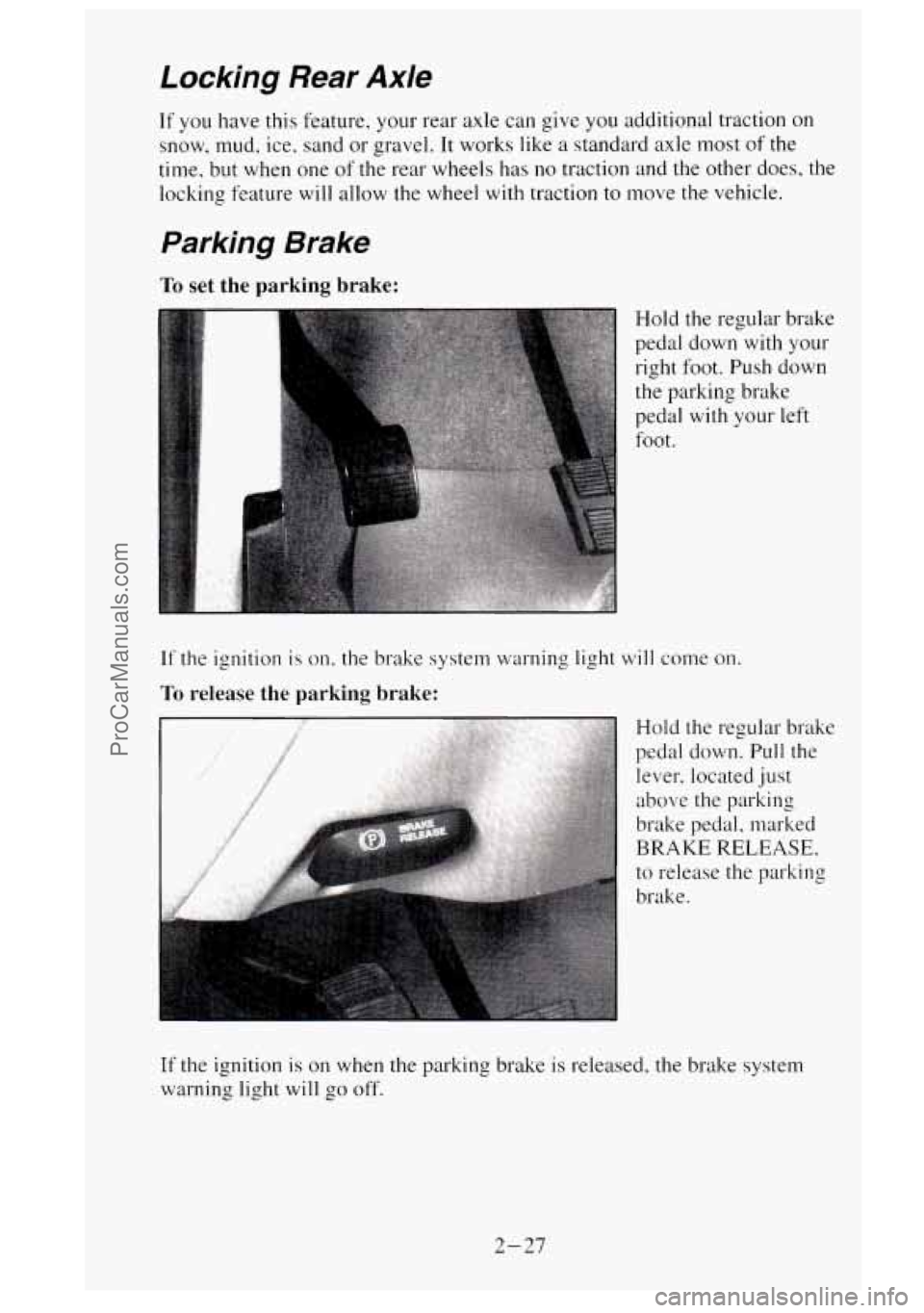
Locking Rear Axle
If you have this feature. your rear axle can give you additional traction on
snow, mud, ice, sand or gravel. It works like a standard axle most
of the
time. but when one
of the rear wheels has no traction and the other does, the
locking feature will allow the wheel with traction to move the vehicle.
Parking Brake
To set the parking brake:
Hold the regular brake
pedal down with your
right foot. Push down
the parking brake
pedal with your left
foot.
If the ignition is on. the brake system warning light will come on.
To release the parking brake:
Hold the regular brake
pedal down. Pull the
lever. located just
above the parking
brake pedal, marked
BRAKE RELEASE,
to release the parking
brake.
If the ignition is on when the parking brake is released, the brake system
warning light will go off.
2-27
ProCarManuals.com
Page 91 of 488
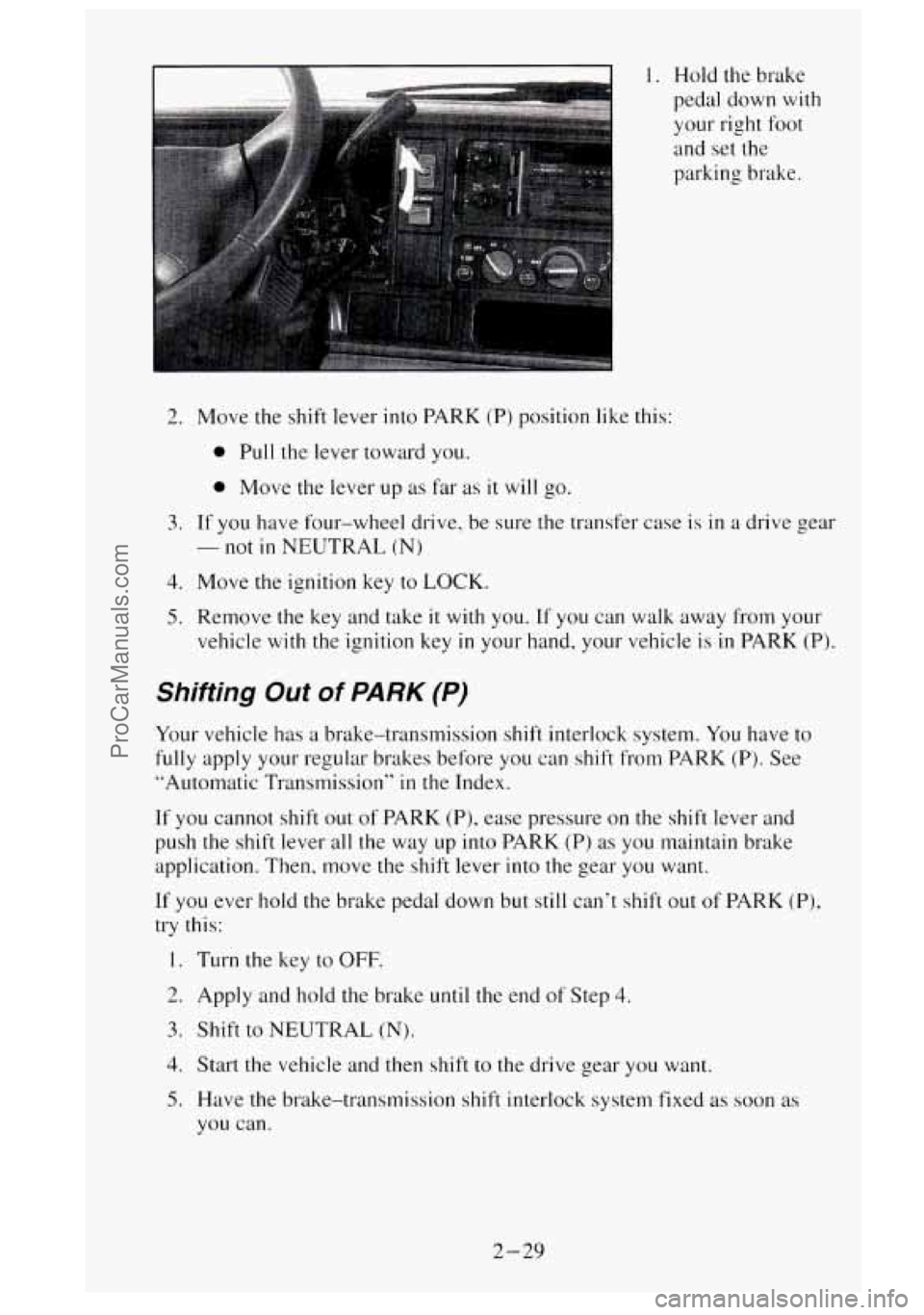
I. Hold the brake
pedal down
with
your right foot
and set the
parking brake.
2. Move the shift lever into PARK (P) position like this:
0 Pull the lever toward you.
0 Move the lever up as far as it will go.
3. If you have four-wheel drive, be sure the transfer case is in a drive gear
- not in NEUTRAL (N)
4. Move the ignition key to LOCK.
5. Remove the key and take it with you. If you can walk away from your
vehicle
with the ignition key in your hand, your vehicle is in PARK (P).
Shifting Out of PARK (P)
Your vehicle has a brake-transmission shift interlock system. You have to
fully apply your regular brakes before you can shift from PARK (P). See
“Automatic Transmission”
in the Index.
If you cannot shift out of PARK (P), ease pressure on the shift lever and
push the shift lever all the way up into PARK (P) as you maintain brake
application. Then, move the shift lever into the gear you want.
If you ever hold the brake pedal down but still can’t shift out of PARK (P),
try this:
1. Turn the key to OFF.
2. Apply and hold the brake until the end of Step 4.
3. Shift to NEUTRAL (N).
3. Start the vehicle and then shift to the drive gear you want.
5. Have the brake-transmission shift interlock system fixed as soon as
you can.
2-29
ProCarManuals.com